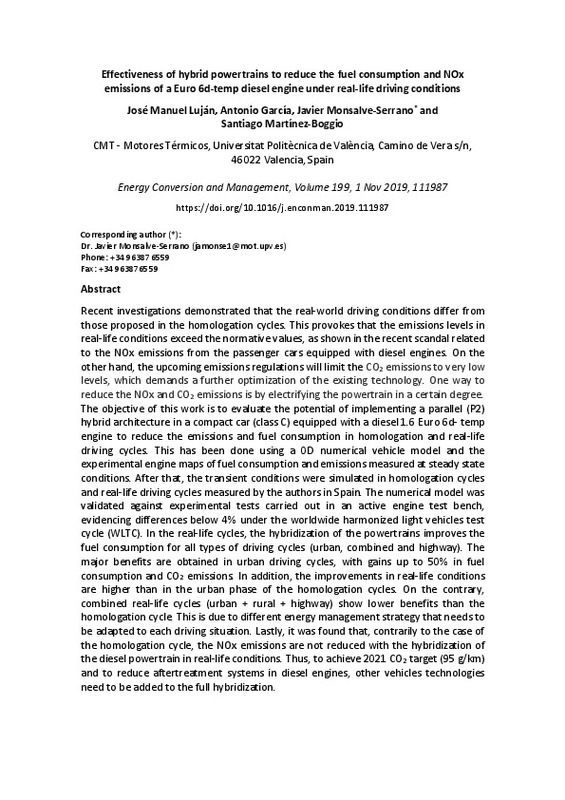JavaScript is disabled for your browser. Some features of this site may not work without it.
Buscar en RiuNet
Listar
Mi cuenta
Estadísticas
Ayuda RiuNet
Admin. UPV
Effectiveness of hybrid powertrains to reduce the fuel consumption and NOx emissions of a Euro 6d-temp diesel engine under real-life driving conditions
Mostrar el registro sencillo del ítem
Ficheros en el ítem
| dc.contributor.author | Luján, José M.
|
es_ES |
| dc.contributor.author | García Martínez, Antonio
|
es_ES |
| dc.contributor.author | Monsalve-Serrano, Javier
|
es_ES |
| dc.contributor.author | Martínez-Boggio, Santiago
|
es_ES |
| dc.date.accessioned | 2020-11-28T04:31:35Z | |
| dc.date.available | 2020-11-28T04:31:35Z | |
| dc.date.issued | 2019-11-01 | es_ES |
| dc.identifier.issn | 0196-8904 | es_ES |
| dc.identifier.uri | http://hdl.handle.net/10251/156018 | |
| dc.description.abstract | [EN] Recent investigations demonstrated that the real-world driving conditions differ from those proposed in the homologation cycles. This provokes that the emissions levels in real-life conditions exceed the normative values, as shown in the recent scandal related to the NOx emissions from the passenger cars equipped with diesel engines. On the other hand, the upcoming emissions regulations will limit the CO2 emissions to very low levels, which demands a further optimization of the existing technology. One way to reduce the NOx and CO2 emissions is by electrifying the powertrain in a certain degree. The objective of this work is to evaluate the potential of implementing a parallel (P2) hybrid architecture in a compact car (class C) equipped with a diesel 1.6 Euro 6d-temp engine to reduce the emissions and fuel consumption in homologation and real-life driving cycles. This has been done using a OD numerical vehicle model and the experimental engine maps of fuel consumption and emissions measured at steady state conditions. After that, the transient conditions were simulated in homologation cycles and real-life driving cycles measured by the authors in Spain. The numerical model was validated against experimental tests carried out in an active engine test bench, evidencing differences below 4% under the worldwide harmonized light vehicles test cycle (WLTC). In the real-life cycles, the hybridization of the powertrains improves the fuel consumption for all types of driving cycles (urban, combined and highway). The major benefits are obtained in urban driving cycles, with gains up to 50% in fuel consumption and CO2 emissions. In addition, the improvements in real-life conditions are higher than in the urban phase of the homologation cycles. On the contrary, combined real-life cycles (urban + rural + highway) show lower benefits than the homologation cycle. This is due to different energy management strategy that needs to be adapted to each driving situation. Lastly, it was found that, contrarily to the case of the homologation cycle, the NOx emissions are not reduced with the hybridization of the diesel powertrain in real-life conditions. Thus, to achieve 2021 CO2 target (95 g/km) and to reduce aftertreatment systems in diesel engines, other vehicles technologies need to be added to the full hybridization. | es_ES |
| dc.description.sponsorship | The authors acknowledge FEDER and Spanish Ministerio de Economia y Competitividad for partially supporting this research through TRANCO project (TRA2017-87694-R). The authors also acknowledge the Universitat Politecnica de Valencia for partially supporting this research through Convocatoria de ayudas a Primeros Proyectos de Investigacion (PAID-06-18). | es_ES |
| dc.language | Inglés | es_ES |
| dc.publisher | Elsevier | es_ES |
| dc.relation.ispartof | Energy Conversion and Management | es_ES |
| dc.rights | Reconocimiento - No comercial - Sin obra derivada (by-nc-nd) | es_ES |
| dc.subject | Hybrid powertrain | es_ES |
| dc.subject | Diesel internal combustion engines | es_ES |
| dc.subject | Emissions regulations | es_ES |
| dc.subject | Driving cycles | es_ES |
| dc.subject.classification | MAQUINAS Y MOTORES TERMICOS | es_ES |
| dc.title | Effectiveness of hybrid powertrains to reduce the fuel consumption and NOx emissions of a Euro 6d-temp diesel engine under real-life driving conditions | es_ES |
| dc.type | Artículo | es_ES |
| dc.identifier.doi | 10.1016/j.enconman.2019.111987 | es_ES |
| dc.relation.projectID | info:eu-repo/grantAgreement/UPV//PAID-06-18/ | es_ES |
| dc.relation.projectID | info:eu-repo/grantAgreement/AEI/Plan Estatal de Investigación Científica y Técnica y de Innovación 2013-2016/TRA2017-87694-R/ES/REDUCCION DE CO2 EN EL TRANSPORTE MEDIANTE LA INYECCION DIRECTA DUAL-FUEL DE BIOCOMBUSTIBLES DE SEGUNDA GENERACION/ | es_ES |
| dc.relation.projectID | info:eu-repo/grantAgreement/UPV//SP20180148/ | es_ES |
| dc.rights.accessRights | Abierto | es_ES |
| dc.contributor.affiliation | Universitat Politècnica de València. Departamento de Máquinas y Motores Térmicos - Departament de Màquines i Motors Tèrmics | es_ES |
| dc.description.bibliographicCitation | Luján, JM.; García Martínez, A.; Monsalve-Serrano, J.; Martínez-Boggio, S. (2019). Effectiveness of hybrid powertrains to reduce the fuel consumption and NOx emissions of a Euro 6d-temp diesel engine under real-life driving conditions. Energy Conversion and Management. 199:1-18. https://doi.org/10.1016/j.enconman.2019.111987 | es_ES |
| dc.description.accrualMethod | S | es_ES |
| dc.relation.publisherversion | https://doi.org/10.1016/j.enconman.2019.111987 | es_ES |
| dc.description.upvformatpinicio | 1 | es_ES |
| dc.description.upvformatpfin | 18 | es_ES |
| dc.type.version | info:eu-repo/semantics/publishedVersion | es_ES |
| dc.description.volume | 199 | es_ES |
| dc.relation.pasarela | S\392512 | es_ES |
| dc.contributor.funder | Agencia Estatal de Investigación | es_ES |
| dc.contributor.funder | European Regional Development Fund | es_ES |
| dc.contributor.funder | Universitat Politècnica de València | es_ES |







![[Cerrado]](/themes/UPV/images/candado.png)

